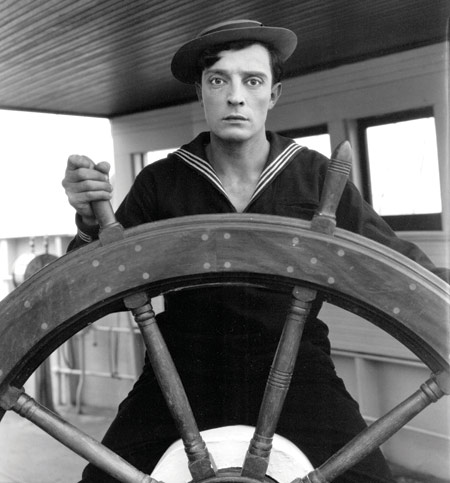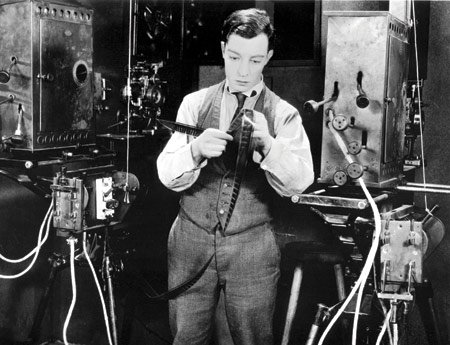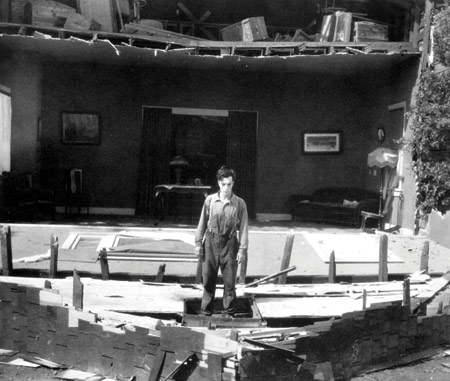BY TERRENCE RAFFERTY
If necessity is the mother of invention, then Joseph Frank Keaton, better known as Buster, must have been the neediest comedy director who ever lived. In his heyday, between 1920 and 1928, Keaton dreamed up visual gags the likes of which had never been imagined, on stage or screen, and he wasn’t stingy either with their number or, especially, their scale. Like his great, unfunny contemporary D.W. Griffith, he thought big. He got laughs with large machines like locomotives and cruise ships, with spectacular forces of nature like waterfalls and cyclones, and when he was on the run, as he usually was, a cast of thousands was often in pursuit. Spectacle isn’t always good for comedy, but Keaton knew how to turn it to his advantage: when you’re watching The Navigator (1924) or The General (1926) or even a two-reeler like Cops (1922), you’re awestruck with laughter.

The Navigator (1924)
All the best of his work is on view in a new Blu-ray box set from Kino Lorber, The Ultimate Buster Keaton Collection, whose 14 discs contain 11 feature films, from The Saphead (1920) through Steamboat Bill, Jr. (1928), 19 remarkable shorts made at his own studio between 1920 and 1923, and—perhaps as a kind of cautionary tale—a disc called “Lost Keaton,” which collects 16 two-reel talkies he starred in for an independent outfit known as Educational Pictures in the 1930s. In most of the silent material, Keaton is credited as either the sole director or a co-director; with the exception of The Saphead, in which he was strictly an actor, he was always in control, working—without benefit of formal shooting scripts—with a small team of gag men and technicians. However the credits read, the comic sensibility of the films is amazingly consistent, and not only because Keaton’s famous deadpan, under a pancake-flat porkpie hat, is at the center of them all. The unchanging wonder of Keaton’s comedy is in the way he plays with the narrow (4:3) frame of silent-era filmmaking: emptying it, filling it with furious action, emptying it again, and always making it seem, somehow, wider and rangier than it is, a sort of CinemaScope of the mind.
He said that if he hadn’t been a performer he would have liked to be an engineer, and it shows: Keaton gags are intricate, meticulously designed machines. Their precision can be thrilling. In the very first short he made at his own studio, One Week (1920), he plays a newlywed building a house from a do-it-yourself kit: the house turns out to be a mess, but the jokes are precise. In one memorable gag (which he would repeat on a grander scale in Steamboat Bill, Jr.), the house facade falls down, in one piece, while he’s in front of it, but he remains unhurt because the spot where he’s standing lines up perfectly with an empty window frame.

Sherlock, Jr. (1924)
That visual joke, like most of Keaton’s best, is filmed from some distance. He once said, “Tragedy is a close-up; comedy, a long shot,” and because tragedy has nothing at all to do with his worldview, close-ups are almost non-existent in his films. He favors the more expansive vistas, as if to assert that there’s nothing funnier, really, than a small man in a vast space. His stage training may have had some influence on his long-shot aesthetic. His mother and father were itinerant vaudevillians, who introduced little Buster into their act when he was all of 4 years old; his part, generally, consisted of being hurled around the stage by his father, Joe. The rough physical comedy of The Three Keatons clearly helped him develop some formidable athletic skills, as well as the ability to project to the cheap seats, far from the stage; he would never need a close-up to get a laugh. Ultimately, of course, he drifted into the young business of the movies beginning in 1917, where he served a brief apprenticeship as second (often third) banana to the unsubtle and hugely popular Roscoe “Fatty” Arbuckle. By the end of that partnership, Keaton had begun to take a hand in directing the Arbuckle shorts, and when he got his own studio in 1920, he was ready.
Almost from the time he was starting to make his own two-reelers, though, he was itching to do features: his humor, unlike that of his contemporary Charlie Chaplin, needed size. Chaplin’s direction focused on capturing the nuances of his own unique comic persona; Keaton’s was about exploring the possibilities of this strange new medium, the ways humor could be engineered within the small, bright square of the movie screen. His short films experimented relentlessly with movement, sometimes using the sides of the screen like the wings of the stage, darting into the frame or out of it, always for a laugh, and sometimes working the vertical axis instead, running straight towards the camera or, when the comic spirit moved him, straight away from it, to the vanishing point, getting smaller and smaller (and funnier) in long shot.
He rarely used optical effects or camera tricks, mostly preferring to stage his jokes with real people and real objects in natural settings. (One conspicuous exception is the 1921 short The Play House, in which he used multiple exposures to allow himself to play all the characters in the opening scenes—every player in an orchestra, every dancer in a notably goofy chorus line.) His sets were the sun-baked streets of Los Angeles and the scrubby hills and canyons not far away, and that was usually all he needed. He never seemed to run out of ways to fill those spaces with furious, kinetic action. In Cops (1922), the streets teem with angry flatfoots; in Seven Chances (1925), with women in bridal regalia all desperate to marry the young heir Buster; in Go West (1925), with puzzled livestock (don’t ask). Outside the city, the hills are alive with comic peril, in the form of giant rockslides (Seven Chances), raging rapids (Our Hospitality [1923]), or peevish Indians (The Paleface [1921]). Keaton, in constant motion and using every inch of the screen, evades them all.

Steamboat Bill, Jr. (1928)
In his short films especially, Keaton established the template for a particularly vigorous brand of physical comedy, which, after him, could only be managed with tricks of different kinds. The most faithful keepers of his slapstick flame were perhaps the wild-man gagsters who toiled in the cartoon unit of the Warner Bros. studios from the late 1930s through the early 1960s—the likes of Bob Clampett and Chuck Jones—who could only achieve visual jokes as complex as Keaton’s by drawing them. There’s a Keatonesque ingenuity, too, in Steven Spielberg’s Indiana Jones pictures, but Spielberg needs small armies of effects technicians to keep those boulders rolling exactly as they should. A good deal of Hong Kong’s energetic action cinema owes a debt to Keaton, as well, but even a director as imaginative as Tsui Hark needs wire work and fast cutting to sustain the whirligig comedy of a movie like Peking Opera Blues (1986).
The beauty of Keaton’s comedy is that everything, no matter how improbable, happens right before your astonished eyes. He shoots slapstick the way a good director films dance: he pulls the camera back to show the whole body, and cuts as little as possible. As a byproduct of his rigorously unfussy approach, the viewer gets to linger a while on the sights up there on the screen, even when the action is breakneck. His shots tend to be long both in distance and duration, and the effect can be jaw-dropping. Among the many majestic gags in The General is a dumbfounding shot in which Keaton, playing a railroad engineer, works on his locomotive in the foreground while in the background a whole regiment of troops is marching to battle. The train, and the tracking camera, are moving swiftly from right to left; the troops, at a stately pace, go from left to right; Buster, focused as always on the task at hand, remains oblivious. The shot is almost too lovely, too elegantly designed, to laugh at. But you do. Who knew geometry could be so funny?
The General is full of moments like that, and so is The Navigator, which was Keaton’s biggest commercial hit and is perhaps the most consistently hilarious of his feature films. Both pictures look terrific in their Blu-ray incarnations, as does the third of his comic masterpieces, Sherlock, Jr. (1924), in which Buster, as a dreaming projectionist, steps right through the screen and into the movie. But even his lesser films have extraordinary sequences, like the chase with the wannabe brides in Seven Chances—which goes on for nearly 20 deranging minutes—or the waterfall rescue near the end of Our Hospitality, which is about as exciting as the ice floe sequence in Griffith’s Way Down East (1920) and, of course, a hell of a lot funnier.
When Keaton was in full control of his work, free to make comedy as he wished, he was an inspired (and inspiring) film artist. Among American directors of the silent era, his only peer was, arguably, Griffith. (Whom he parodies in Three Ages [1923] and pays affectionate homage to in Our Hospitality.) But the condition of Hollywood filmmaking began to change in the late ’20s, and Keaton was no luckier than Griffith in the new, assembly-line studio system. In 1928, against the advice of his friend Chaplin, he signed a contract with MGM and gave up his studio, quickly losing the autonomy his distinctive art required: the risk-averse studio bosses didn’t trust his seat-of-the-pants approach to comedy, and before too long turned him into just another contract player, acting for journeyman directors in formula fluff. Years later, he started doing the Educational two-reelers included in the Kino box set, and by that time he looked about 20 years older than he had in Steamboat Bill, Jr. He’s still game, still a pro, and the shorts are perfectly pleasant, but without his direction they’re not Keaton films. And as it turned out there would never be a true Keaton film again. For the remaining three decades of his life, he worked steadily and sometimes happily as an actor or a gagman-for-hire: a better second act than Griffith’s, but much less than he deserved. As this Blu-ray box proves irrefutably, Buster Keaton wasn’t only the greatest director of film comedy. He pretty much invented it.